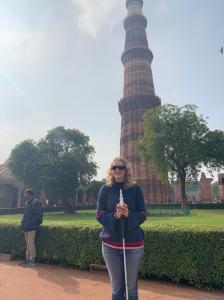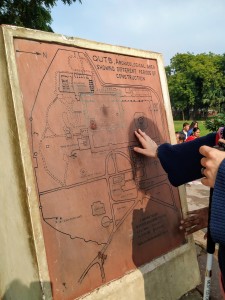This is the first of two blog posts on my recent trip to India. In this one, I will focus more on what it was like travelling to and around Delhi. The second one will focus more on the research I did while I was in Delhi. Make sure to read both!!
Step 1: Getting out of the airport – the adventure that is special assistance service
As always, the first hurdle is to get out of the airport. To help me find my way around unknown airports, I use the special assistance service that is available at most (international) airports. All around the world, the quality of their service can be a bit of a hit and miss. I had everything from being forgotten in some lonely corner of Frankfurt airport, delaying other peoples’ flights because nobody picked me up from an airplane parked at a remote stand and the bus had left, to amazing people who were considerate and helpful.
So I was curious to find out what the service would be like at Delhi airport. We were greeted by the coordinator, who immediately asked me to sit in a wheelchair, which I refused. This happens frequently; assistance staff trying to make me sit in a wheelchair. Often their argument is “it’s easier and faster”. They of course talk about themselves and not me. I don’t want to sit in a wheelchair – I can walk. They should keep the wheelchairs for those travelers who actually need them. Yet, staff can get quite persistent to the point that I once told an assistance staff member that they can push the wheelchair and walk as fast as they want and that I would walk next to them with my guide dog Lassie. I told them that if I couldn’t keep up and slowed them down, I would sit in the wheelchair. They were panting at the end – my guide dog comes with the high-speed configuration.
But back to India. They kept trying to get me to sit in a wheelchair. After they realised I wouldn’t, they simply ignored us. Only afterwards did we find out why they were so persistent. It had to do with cost. The company employing those who push the wheelchairs is a 3rd party contractor that is quite a lot cheaper; the staff that walk with you are members of the airline or ground staff which are more expensive.
Next up: the immigration desk. Delhi airport has two special assistance immigration desks. I was first asked why I was there so I said that I was registered blind. The officer didn’t seem convinced but went with it. Then when I had to put my fingers on the fingerprint scanner, he decided that I must be faking it. You’re wondering why? Quite simple. My ATW assistant had put my left hand on it, the immigration officer then asked me to put my right hand on it which I did without any help. So the immigration officer asked my assistant how I knew where it was (I mean I had my other hand on it). Then he apparently held up a hand and asked me which one and then he banged a plastic bottle on his desk and asked me what it was. In the end, he stamped my passport and we went through.
Similar things happened on the way out. The border officer’s response to me telling him I was blind was “why?”. To be frank, I didn’t quite know how to respond to that. At security, people were confused that I needed help as I had to put my cane through the scanner and then had nothing to help me. This is particularly tricky in India as there are male and female security lines and my ATW assistant is male. So I couldn’t go with him and he couldn’t go with me.
Step 2: Exploring Delhi for half a day – an unforgettable and sensory-overloading experience
After arriving at the hotel at 3am, it was time for a quick sleep as our first meeting was at 11am which required a 10am departure. Luckily, the first meeting was about accessible tourism – tourism that works for anyone with a disability. Neha, the founder of Planet Abled, had the wonderful idea to not just talk to me about her work but to show me. She said as I was registered blind, it would help me understand her work. So half a day of a guided tour through Delhi it was.

It was an amazing experience. We started off at Qutub Minar – a very old outside Mosque. This part of our trip was very tactile. I touched a lot of the amazing stonework and the carvings in the pillars, walls and gates. As the actual Minar is fenced of, Planet Abled provided a 3D-printed model for me to feel. We walked around, the guide was full of fascinating information and I was given lots of time to explore the place with my hands. For those of you who have full vision, this might seem slightly odd but for us who can’t see, touching carvings, walking the length of something, getting comparisons to how high or wide things are, helps build up a mental image of what we are looking at. It brings a place to life.
We then drove towards Old Delhi. This took longer than expected due to the severe traffic caused by the protests that happened in Delhi in December 2019. When we arrived in Old Delhi, we had to walk for a bit to get to our lunch place. It was incredible, the buzzle, all the sounds and smells and constant movement. We went into this tiny courtyard and had some amazing lunch. We then took a TukTuk ride into Old Delhi. This part was hilarious. I couldn’t stop laughing. You have to sit with your arms tucked in as otherwise your elbow bumps into someone. Due to the potholes, all the weaving in and out of other TukTuks, bikes, carts and, yes, cows, it felt like being on a rollercoaster. It was just so much fun. We stopped a few times, explored various shops, had street food, tasted and smelled the spices in the spice market and even climbed up on top of one of the buildings surrounding the spice market. From up there, the soundscape was fascinating, it was noisy and quiet at the same time. I could hear the sounds from the spice market on one side and the cars and people throughout Old Delhi. At the same time, the mosque that was right behind us -again mostly open air – emitted a calmness and quiet. In combination, it was a fascinating mixture.


We went back to our car. The driver was really nice and by then had observed how I unfolded and folded my cane. He asked me if he could do it and took a lot of pride in doing this every time I left the car or got back into it. He handled it like a precious object.
The last stop for us was the large Sikh Temple, Gurudwara Bangla Sahib. We had to take off our shoes and cover our hair, then wash our hands and walk through a water basin. Inside the temple, a priest was singing, and we walked around in a circle. It was truly relaxing and a proper island of calmness. Outside, I explored the carvings with my hands. We walked to the kitchen and I helped out a bit – or at least tried as I don’t think I did a good job. The other volunteer was really patient with me while I was trying to roll the dough properly (I’m not a good baker; I’m only good at eating cookie dough). We then joined the free communal dinner, sitting on a rough mat on the floor, eating with our fingers.
At the end of the day, I was exhausted, and my senses were overloaded – but in a good way. Delhi is amazing to explore as a visually impaired person, so many smells (good and not so good), sounds, tastes and things to touch. I didn’t feel that I missed out on any of the experiences one can have in Delhi.
Final step: rest of the trip and reflections
For most of the rest of the trip, we had the same driver who was simply amazing and always made sure, he dropped us off right outside where we had to go. How important this was, became apparent to us on the last day of our stay in Delhi. We had a new driver and he dropped us off in a parking lot and then just said something like “it’s behind that building” so we went there. We got stopped by security people who told us that it was behind some railing in an alley. By that point, I had no idea what was happening as I couldn’t see where everyone was pointing. We walked on, found an alley but could still not find the office of the social venture we were heading to. In the end, I gave my phone to a security guard who explained in Hindi to our contact where we were, and she came to pick us up.
The other experience that reminded me of my time in Uganda was how my sheer presence confused people. And I mean really confused the; some even stopped whatever they were doing and froze. The sight of a white, blond tourist with a cane seemed to be perplexing to people. My assistant constantly told me about peoples’ reactions. This was of course more than in Uganda but I hardly spent time outside of meetings and the car in Uganda. Again, the notion that the West has no disabilities was the root of this response.
I honestly can’t wait to go back and experience more of this country that truly can overpower your senses, in a good way.
So now, let’s get onto the research I did while in India. Read all about it in this blog post.

3 responses to “India #1: a sensory travel experience”
Great post 🙂
LikeLiked by 1 person
thank you
LikeLike
[…] is my second blog post on my 8-day research journey to New Delhi, India. The first one was more on the experience of travelling in India with a visual disability, this one is more about […]
LikeLike